Relevant Posts on Papers
“Computational Social Sciences: Current and Future Challenges”
Summary of our work in the area (2017)
Y. Moreno
This entry corresponds to a talk I gave recently in which I summarize the work done in COSNET Lab in the broad area of Computational Social Sciences. It includes a recap of current challenges, our main works on the structure and dynamics of Online Social Systems as well as several of our behavioral experiments in which humans face different social dilemmas.
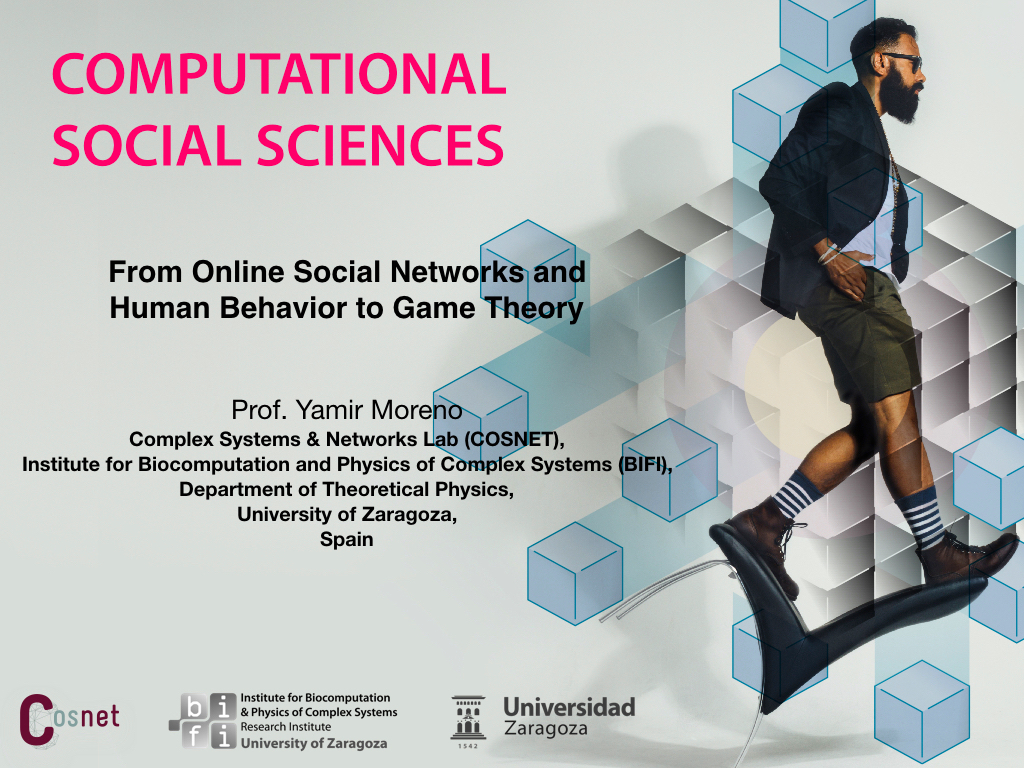
“Modeling the effects of network structure, competition and memory time on social spreading phenomena”
Physical Review X 6, 021019 (2016)
J. P. Gleeson, K. P. O’Sullivan, R. A. Baños & Y. Moreno
Online social media have greatly affected the way in which we communicate with each other. However, little is known about what are the fundamental mechanisms driving dynamical information flow in online social systems. Here, we introduce a generative model for online sharing behavior that is analytically tractable and which can reproduce several characteristics of empirical micro-blogging data on hashtag usage, such as (time-dependent) heavy-tailed distributions of meme popularity. The presented framework constitutes a null model for social spreading phenomena which, in contrast to purely empirical studies or simulation-based models, clearly distinguishes the roles of two distinct factors affecting meme popularity: the memory time of users and the connectivity structure of the social network.
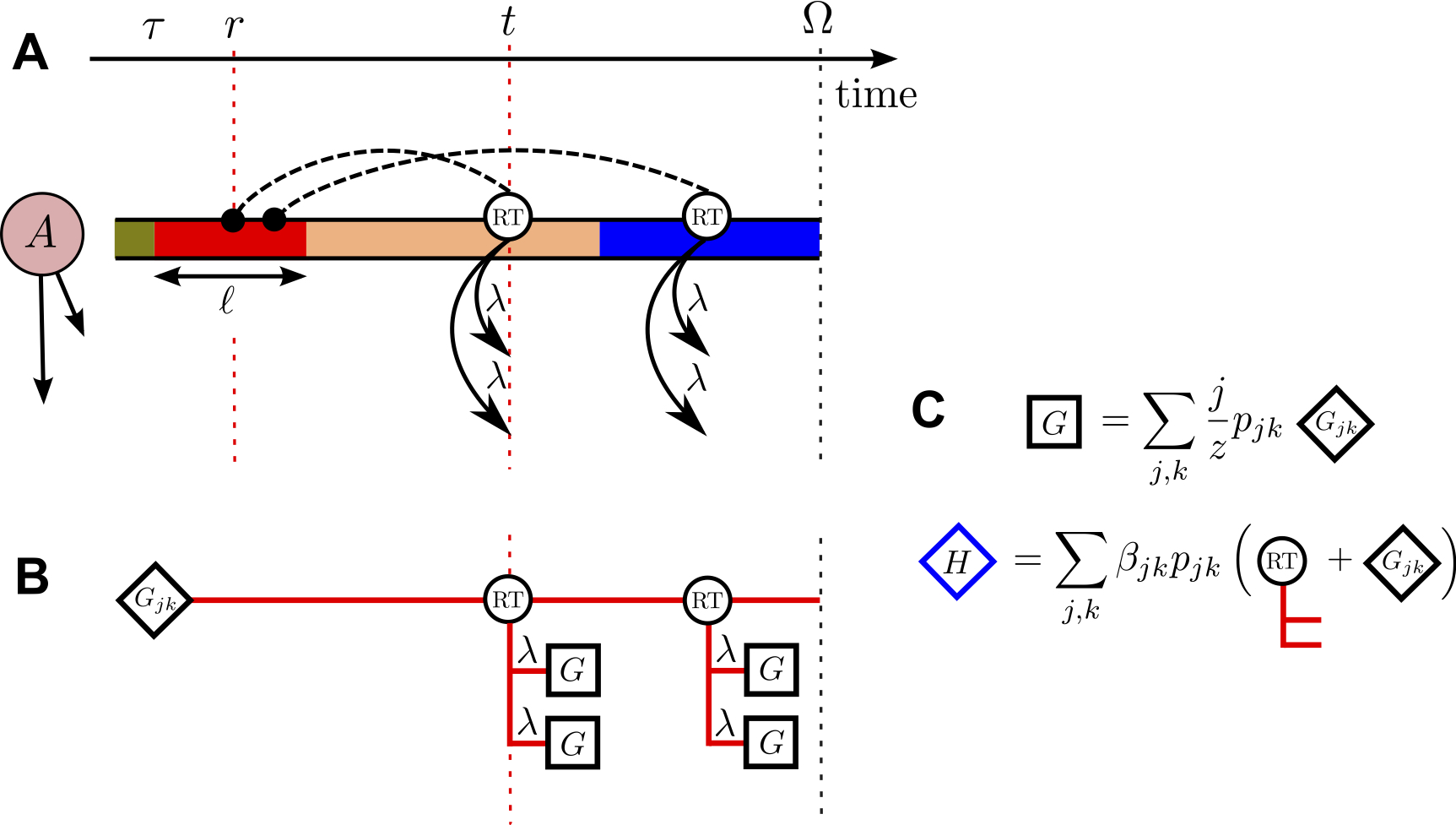
“Spatiotemporal characterization of information-driven collective phenomena through transfer entropy”
Science Advance 2, e1501158 (2016)
J. Borge-Holthoefer, N. Perra, B. Goncalves, S. Gonzalez-Bailon, A. Arenas, Y. Moreno & A. Vespignani
Data from social media provide unprecedented opportunities to investigate the processes that govern the dynamics of collective social phenomena. We consider an information theoretical approach to define and measure the temporal and structural signatures typical of collective social events as they arise and gain prominence. We use the symbolic transfer entropy analysis of microblogging time series to extract directed networks of influence among geolocalized subunits in social systems. This methodology captures the emergence of system-level dynamics close to the onset of socially relevant collective phenomena. The framework is validated against a detailed empirical analysis of five case studies. In particular, we identify a change in the characteristic time scale of the information transfer that flags the onset of information-driven collective phenomena. Furthermore, our approach identifies an order-disorder transition in the directed network of influence between social subunits. In the absence of clear exogenous driving, social collective phenomena can be represented as endogenously driven structural transitions of the information transfer network. This study provides results that can help define models and predictive algorithms for the analysis of societal events based on open source data.

“Characterizing two-pathogen competition in spatially structured environments”
Scientific Reports 5, 7895 (2015)
C. Poletto, S. Meloni, A. Van Metre, V. Colizza, Y. Moreno & A. Vespignani
Different pathogens spreading in the same host population often generate complex co-circulation dynamics because of the many possible interactions between the pathogens and the host immune system, the host life cycle, and the space structure of the population. Here we focus on the competition between two acute infections and we address the role of host mobility and cross-immunity in shaping possible dominance/co-dominance regimes. Host mobility is modelled as a network of traveling flows connecting nodes of a metapopulation, and the two-pathogen dynamics is simulated with a stochastic mechanistic approach. Results depict a complex scenario where, according to the relation among the epidemiological parameters of the two pathogens, mobility can either be non-influential for the competition dynamics or play a critical role in selecting the dominant pathogen. The characterisation of the parameter space can be explained in terms of the trade-off between pathogen’s spreading velocity and its ability to diffuse in a sparse environment. Variations in the cross-immunity level induce a transition between presence and absence of competition. The present study disentangles the role of the relevant biological and ecological factors in the competition dynamics, and provides relevant insights into the spatial ecology of infectious diseases.

“Reputation drives cooperative behavior and network formation in human groups”
Scientific Reports 5, 7843 (2015)
J. A. Cuesta, C. Gracia-Lazaro, A. Ferrer, Y. Moreno & A. Sánchez
Cooperativeness is a defining feature of human nature. Theoreticians have suggested several mechanisms to explain this ubiquitous phenomenon, including reciprocity, reputation, and punishment, but the problem is still unsolved. Here we show, through experiments conducted with groups of people playing an iterated Prisoner’s Dilemma on a dynamic network, that it is reputation what really fosters cooperation. While this mechanism has already been observed in unstructured populations, we find that it acts equally when interactions are given by a network that players can reconfigure dynamically. Furthermore, our observations reveal that memory also drives the network formation process, and cooperators assort more, with longer link lifetimes, the longer the past actions record. Our analysis demonstrates, for the first time, that reputation can be very well quantified as a weighted mean of the fractions of past cooperative acts and the last action performed. This finding has potential applications in collaborative systems and e-commerce.

“Dynamics of interacting diseases”
Physical Review X 4, 041005 (2014)
Joaquin Sanz, ChenYi Xia, Sandro Meloni and Yamir Moreno
Current modeling of infectious diseases allows for the study of complex and realistic scenarios that go from the population to the individual level of description. However, most epidemic models assume that the spreading process takes place on a single level (be it a single population, a metapopulation system, or a network of contacts). In particular, interdependent contagion phenomena can be addressed only if we go beyond the scheme-one pathogen-one network. In this paper, we propose a framework that allows us to describe the spreading dynamics of two concurrent diseases. Specifically, we characterize analytically the epidemic thresholds of the two diseases for different scenarios and compute the temporal evolution characterizing the unfolding dynamics. Results show that there are regions of the parameter space in which the onset of a disease’s outbreak is conditioned to the prevalence levels of the other disease. Moreover, we show, for the susceptible-infected-susceptible scheme, that under certain circumstances, finite and not vanishing epidemic thresholds are found even at the limit for scale-free networks. For the susceptible- infected-removed scenario, the phenomenology is richer and additional interdependencies show up. We also find that the secondary thresholds for the susceptible-infected-susceptible and susceptible-infected-removed models are different, which results directly from the interaction between both diseases. Our work thus solves an important problem and paves the way toward a more comprehensive description of the dynamics of interacting diseases.
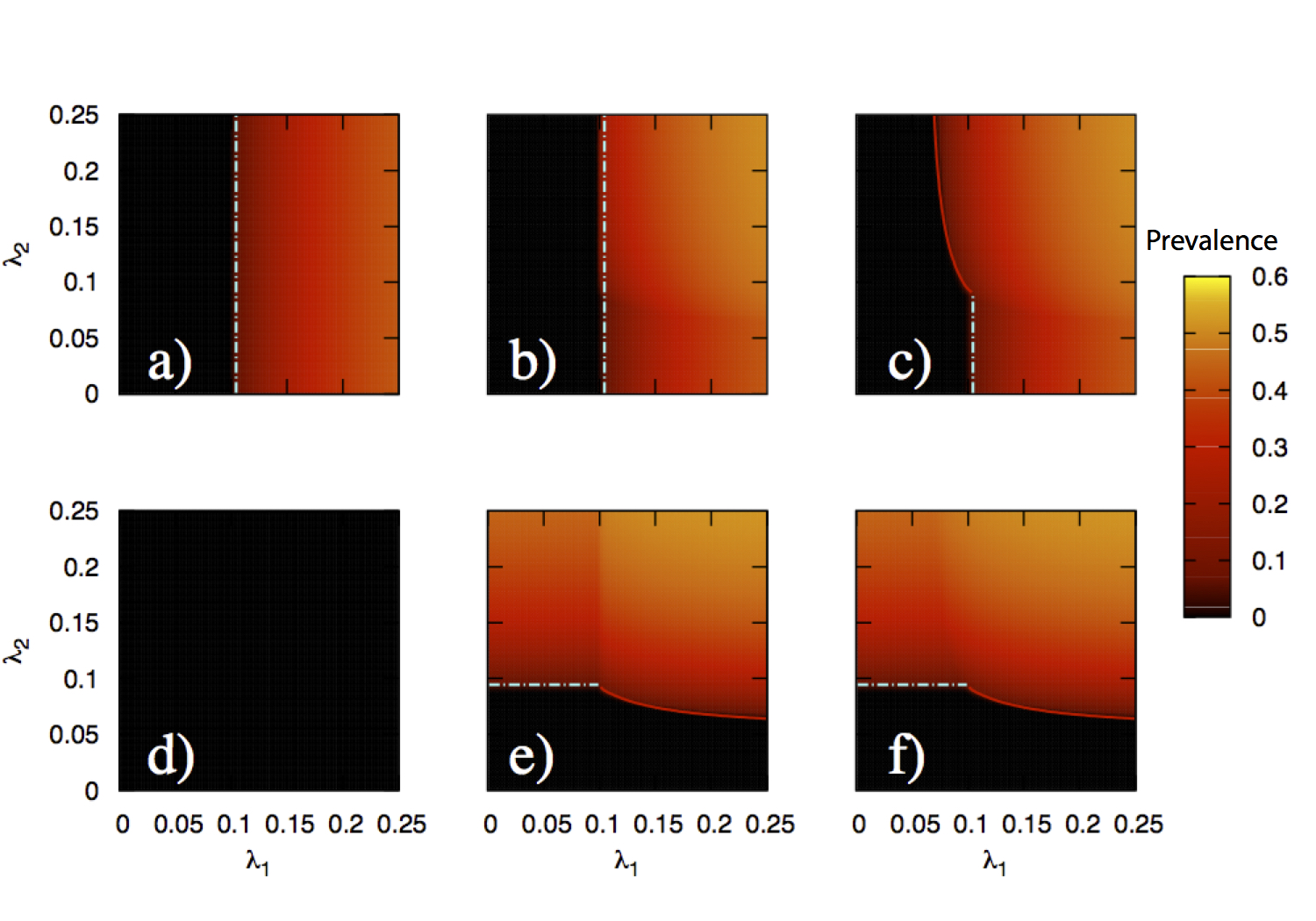
“Contact-based Social Contagion in Multiplex Networks”
Physical Review E 88, 050801(R) (2013)
Emanuele Cozzo, Raquel A. Baños, Sandro Meloni and Yamir Moreno
In this work, we develop a theoretical framework for the study of epidemic like social contagion in large-scale social systems. We consider the most general setting in which different communication platforms or categories form multiplex networks. Specifically, we propose a contact-based information spreading model, and show that the critical point of the multiplex system associated with the active phase is determined by the layer whose contact probability matrix has the largest eigenvalue. The framework is applied to a number of different situations, including a real multiplex system. Finally, we also show that when the system through which information is disseminating is inherently multiplex, working with the graph that results from the aggregation of the different layers is inaccurate.
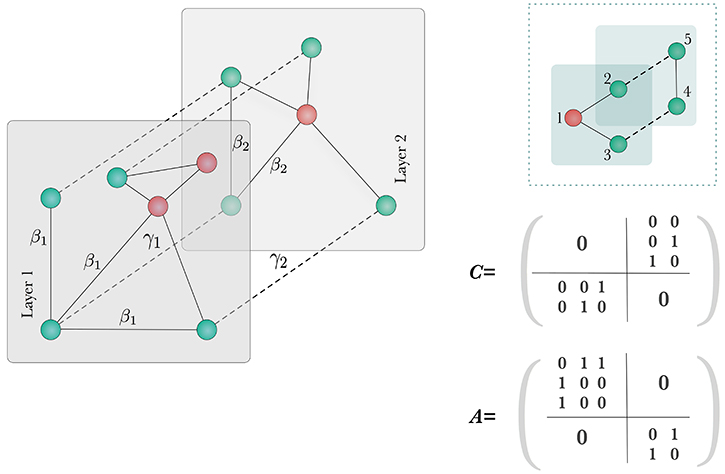
“The Role of Hidden Influentials in the Diffusion of Online Information Cascades”
EPJ Data Science 2:6 (2013)
Raquel A. Baños, Javier Borge–Holthoefer and Yamir Moreno
 In a diversified context with multiple social networking sites, heterogeneous activity patterns and different user-user relations, the concept of ‘information cascade’ is all but univocal. Despite the fact that such information cascades can be defined in different ways, it is important to check whether some of the observed patterns are common to diverse contagion processes that take place on modern social media. Here, we explore one type of information cascades, namely, those that are timeconstrained, related to two kinds of socially-rooted topics on Twitter. Specifically, we show that in both cases cascades sizes distribute following a fat-tailed distribution and that whether or not a cascade reaches system-wide proportions is mainly given by the presence of so-called hidden influentials. These latter nodes are not the hubs, which on the contrary, often act as firewalls for information spreading. Our results contribute to a better understanding of the dynamics of complex contagion and, from a practical side, for the identification of efficient spreaders in viral phenomena.
In a diversified context with multiple social networking sites, heterogeneous activity patterns and different user-user relations, the concept of ‘information cascade’ is all but univocal. Despite the fact that such information cascades can be defined in different ways, it is important to check whether some of the observed patterns are common to diverse contagion processes that take place on modern social media. Here, we explore one type of information cascades, namely, those that are timeconstrained, related to two kinds of socially-rooted topics on Twitter. Specifically, we show that in both cases cascades sizes distribute following a fat-tailed distribution and that whether or not a cascade reaches system-wide proportions is mainly given by the presence of so-called hidden influentials. These latter nodes are not the hubs, which on the contrary, often act as firewalls for information spreading. Our results contribute to a better understanding of the dynamics of complex contagion and, from a practical side, for the identification of efficient spreaders in viral phenomena.
“Host Mobility Drives Pathogen Competition in Spatially Structured Populations”
PLoS Computational Biology, 9 (8): e1003169 (2013)
Chiara Poletto, Sandro Meloni, Vittoria Colizza, Yamir Moreno and Alessandro Vespignani
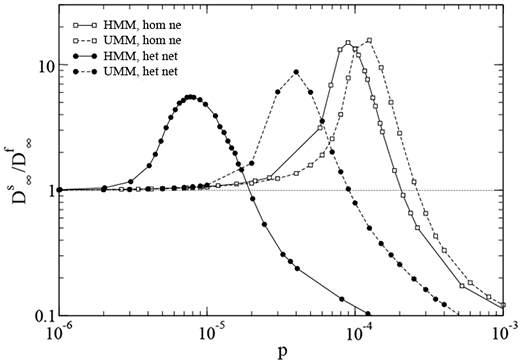 Interactions among multiple infectious agents are increasingly recognized as a fundamental issue in the understanding of key questions in public health regarding pathogen emergence, maintenance, and evolution. The full description of host- multipathogen systems is, however, challenged by the multiplicity of factors affecting the interaction dynamics and the resulting competition that may occur at different scales, from the within-host scale to the spatial structure and mobility of the host population. Here we study the dynamics of two competing pathogens in a structured host population and assess the impact of the mobility pattern of hosts on the pathogen competition. We model the spatial structure of the host population in terms of a metapopulation network and focus on two strains imported locally in the system and having the same transmission potential but different infectious periods. We find different scenarios leading to competitive success of either one of the strain or to the codominance of both strains in the system. The dominance of the strain characterized by the shorter or longer infectious period depends exclusively on the structure of the population and on the mobility of hosts across patches. The proposed modeling framework allows the integration of other relevant epidemiological, environmental and demographic factors, opening the path to further mathematical and computational studies of the dynamics of multipathogen systems.
Interactions among multiple infectious agents are increasingly recognized as a fundamental issue in the understanding of key questions in public health regarding pathogen emergence, maintenance, and evolution. The full description of host- multipathogen systems is, however, challenged by the multiplicity of factors affecting the interaction dynamics and the resulting competition that may occur at different scales, from the within-host scale to the spatial structure and mobility of the host population. Here we study the dynamics of two competing pathogens in a structured host population and assess the impact of the mobility pattern of hosts on the pathogen competition. We model the spatial structure of the host population in terms of a metapopulation network and focus on two strains imported locally in the system and having the same transmission potential but different infectious periods. We find different scenarios leading to competitive success of either one of the strain or to the codominance of both strains in the system. The dominance of the strain characterized by the shorter or longer infectious period depends exclusively on the structure of the population and on the mobility of hosts across patches. The proposed modeling framework allows the integration of other relevant epidemiological, environmental and demographic factors, opening the path to further mathematical and computational studies of the dynamics of multipathogen systems.
“Heterogeneous networks do not promote cooperation when humans play a Prisoner’s Dilemma”
Proceedings of the National Academy of Sciences USA, 109: 12922-12926 (2012)
Carlos Gracia-Lázaro , Alfredo Ferrer , Gonzalo Ruíz , Alfonso Tarancón , Jose A. Cuesta , Anxo Sánchez, and Yamir Moreno
It is not fully understood why we cooperate with strangers on a daily basis. In an increasingly global world, where interaction networks and relationships between individuals are becoming more complex, different hypotheses have been put forward to explain the foundations of human cooperation on a large scale and to account for the true motivations that are behind this phenomenon. In this context, population structure has been suggested to foster cooperation in social dilemmas, but theoretical studies of this mechanism have yielded contradictory results so far; additionally, the issue lacks a proper experimental test in large systems. We have performed the largest experiments to date with humans playing a spatial Prisoner’s Dilemma on a lattice and a scale-free network (1,229 subjects). We observed that the level of cooperation reached in both networks is the same, comparable with the level of cooperation of smaller networks or unstructured populations. We have also found that subjects respond to the cooperation that they observe in a reciprocal manner, being more likely to cooperate if, in the previous round, many of their neighbors and themselves did so, which implies that humans do not consider neighbors’ payoffs when making their decisions in this dilemma but only their actions. Our results, which are in agreement with recent theoretical predictions based on this behavioral rule, suggest that population structure has little relevance as a cooperation promoter or inhibitor among humans.


